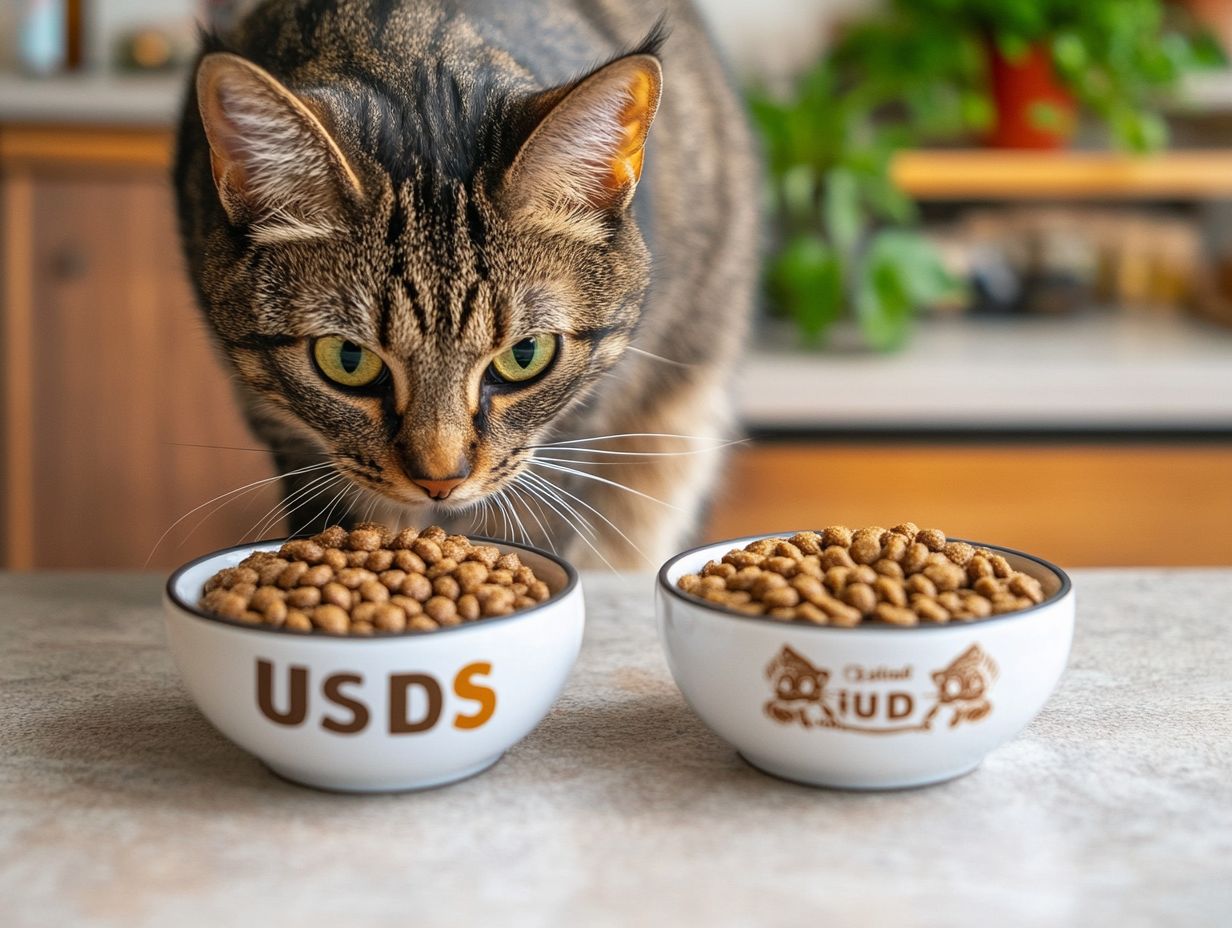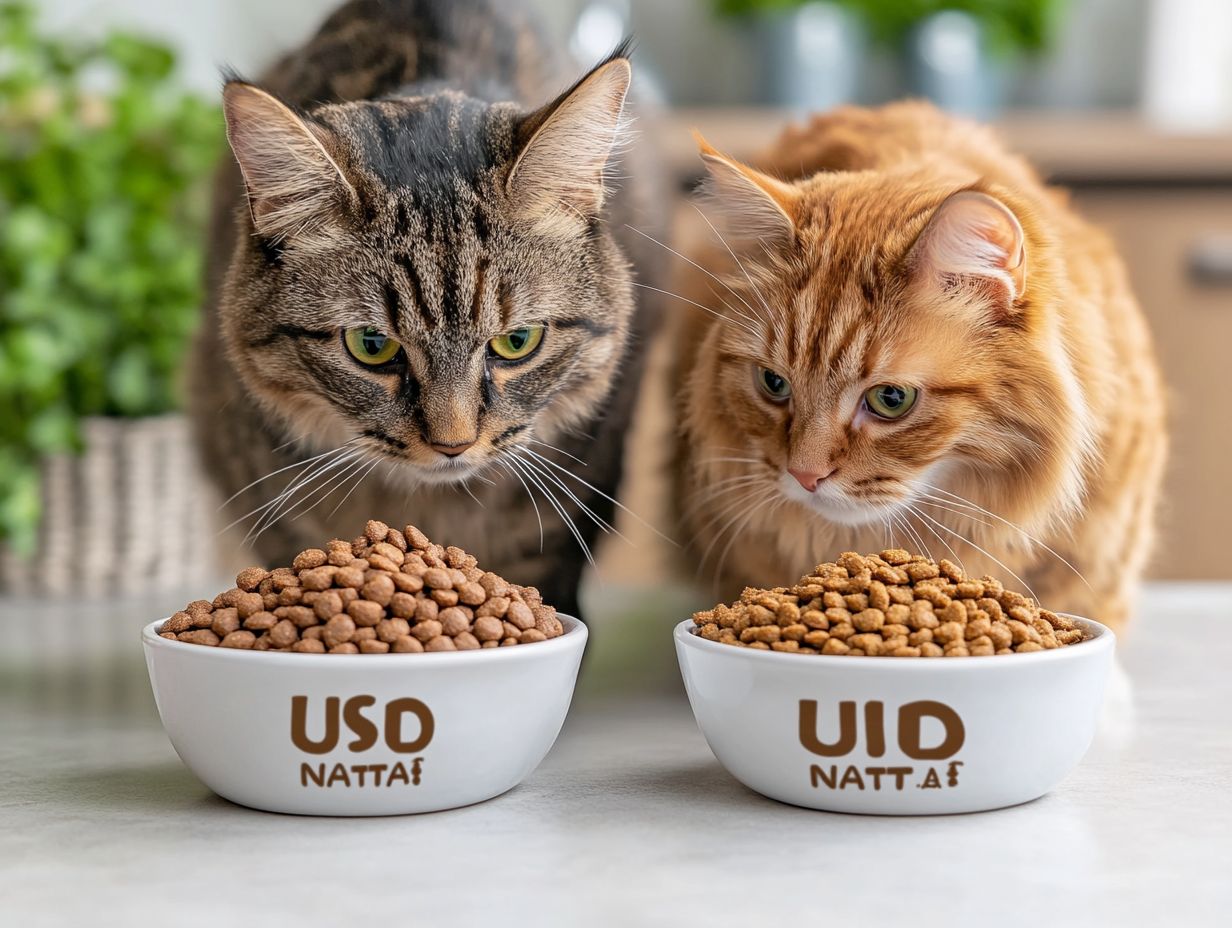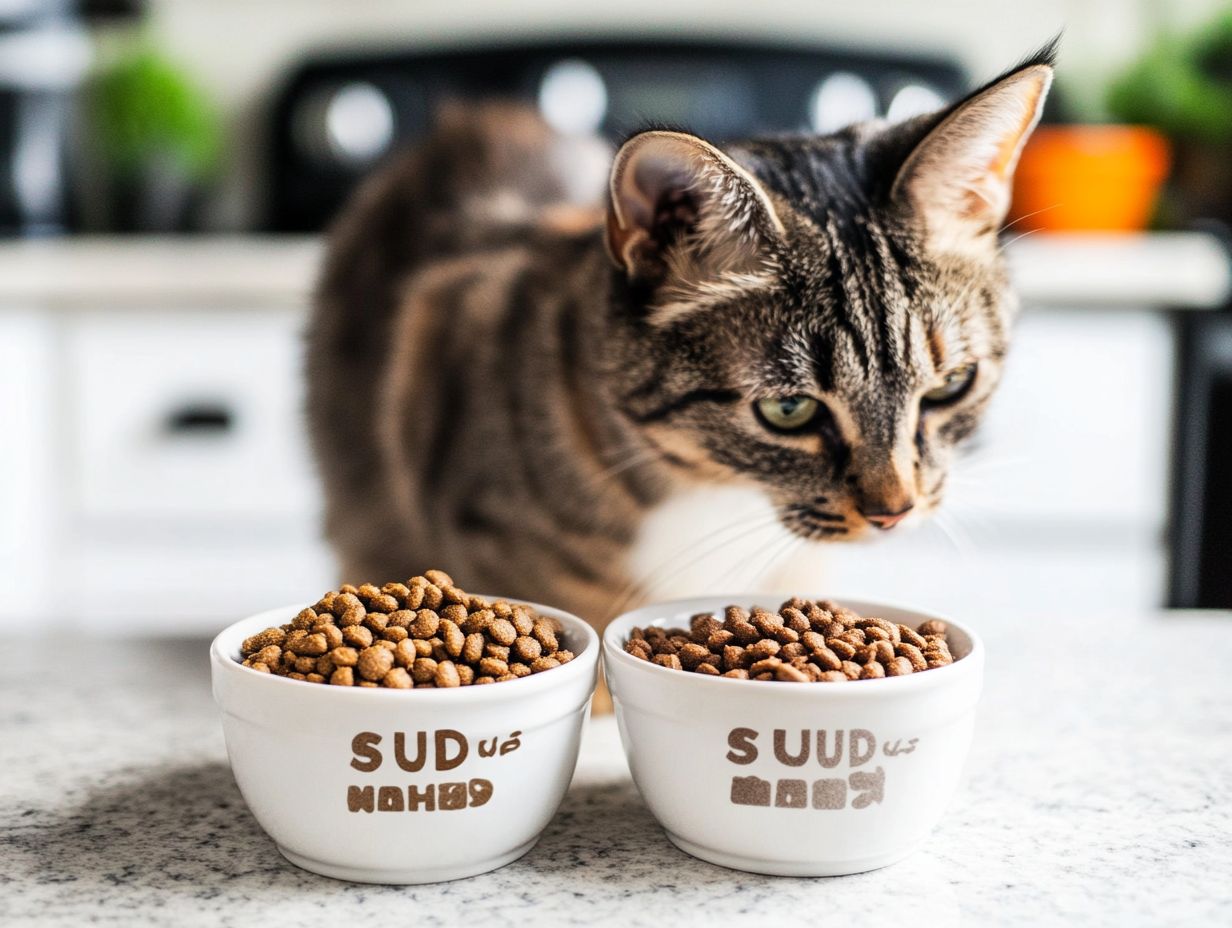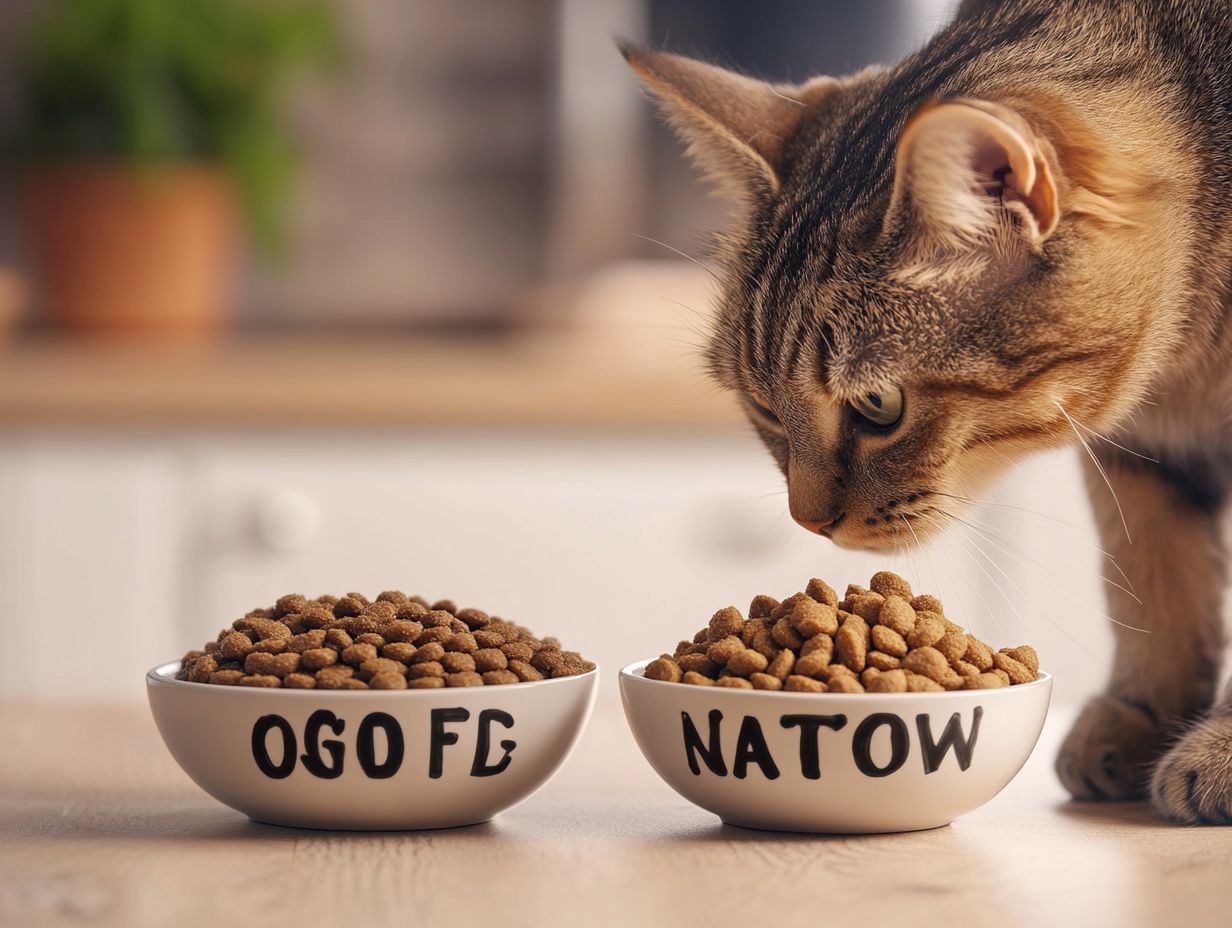Choosing the right cat food can be a daunting task, especially with the growing popularity of organic and natural options like Instinct and Natural Balance. As obligate carnivores, cats have a biological need for animal-source proteins, which are vital for their health and well-being. While organic and natural labels may appeal to conscious pet owners, it is crucial to prioritize the quality and source of protein in your cat’s diet.
Understanding what these terms mean is crucial for making informed decisions about your feline friend’s diet, considering vet recommendations and potential cat food allergies. Always consult with a veterinarian before making significant changes to your cat’s diet, particularly for those with specific health issues like IBD, kidney disease, or diabetes.
This article explores the definitions of organic and natural cat food, highlights their key differences, and helps you determine which option best suits your cat’s unique health needs, including considerations for a grain-free diet. We also address common allergens, practical feeding advice, and the implications of raw diets.
Join us as we navigate the intricacies of these two popular choices for conscious pet owners, emphasizing weight management and improved digestion for optimal feline health.
Key Takeaways:

What Is Organic Cat Food?
Organic cat food is made from 100% certified organic ingredients that are produced without the use of synthetic chemicals or pesticides. High-quality organic cat food is formulated to meet AAFCO standards, ensuring optimal health and nutrition for cats. Additionally, brands like Blue Buffalo emphasize animal-source proteins to support a nutritious cat diet.
It promotes sustainable and environmentally friendly farming practices while offering a diverse range of animal proteins, which help ensure that cats receive the essential nutrients they need. While fruits and vegetables can be included, they should not constitute the primary source of nutrition, as cats require animal-source proteins for essential amino acids.
1. Organic Ingredients
Organic cat food is crafted from high-quality ingredients sourced from organic farms, ensuring that it is free from harmful pesticides and chemicals, thus contributing to a natural diet for your cats. However, it is essential to recognize that plant-based ingredients should not replace animal proteins, as they do not provide the complete nutrition cats need.
These foods typically feature a variety of animal proteins, such as chicken, turkey, or fish, which provide essential amino acids crucial for muscle development and overall energy. Organic fruits and vegetables, like blueberries, potatoes, and carrots, may offer antioxidants and fiber that promote a healthy digestive system, but should not be relied upon as the main nutrient source.
By choosing organic ingredients, cat owners can enhance their pets’ optimal health, minimize the risk of exposure to harmful substances, and support sustainable farming practices, benefiting both the environment and animal welfare.
2. No Artificial Preservatives or Colors
One of the defining features of organic cat food is that it is free from artificial preservatives and colors, making it a healthier choice for your pet. Many commercial cat food brands rely on synthetic chemicals and artificial additives to enhance flavor, extend shelf life, or improve visual appeal.
However, these additives can pose serious health risks to cats, including allergies, digestive issues, and, in some cases, long-term organ damage. Scientific studies have highlighted the negative impacts of such additives specifically on feline health, reinforcing the importance of opting for organic options. By choosing organic cat food, pet owners can ensure their cats receive natural ingredients, thereby reducing the likelihood of these harmful health effects.
Organic options provide better overall nutrition, which supports your cat’s well-being and contributes to a longer, healthier life. Such choices have a significantly positive impact on the health outcomes of our beloved companions.
3. No Antibiotics or Hormones
Organic cat food is strictly regulated to ensure it contains no antibiotics or hormones, which are commonly used in conventional production and can contribute to various health issues in cats. This aligns with CodaPet’s mission to promote animal welfare and sustainability across California.
By avoiding these synthetic additives, organic options promote better digestion, allowing cats to absorb nutrients more effectively. As a result, many owners notice that their cats have healthier coats and increased energy levels, both of which are indicators of improved overall wellbeing.
Feeding Considerations
When considering organic or natural diets, it’s essential to factor in your cat’s life stage—kittens, seniors, and pregnant or nursing cats all have different nutritional needs. Always consult with your veterinarian to ensure that your chosen diet is appropriate for your cat’s specific requirements.
The Pros and Cons of Raw Diets
Raw diets can offer nutritional benefits, but they also come with potential risks, including nutritional deficiencies and food safety concerns. Consult with a veterinarian to determine if a raw diet is suitable for your cat and how to implement it safely.
Eliminating these substances can significantly reduce the risk of developing allergies, a common concern for pet owners. Cats that consume food free from harmful additives are less likely to experience gastrointestinal distress and skin irritations, leading to a better quality of life and a stronger immune system in the long run.
What Is Natural Cat Food?
Natural cat food is a type of pet food that emphasizes high-quality, animal-source proteins and natural ingredients to provide cats with a balanced diet that fulfills their nutritional needs without the inclusion of artificial additives or synthetic chemicals. This type of food aligns with veterinary recommendations (see AVMA guidelines) and is often an excellent choice for cats with allergies.
Natural cat foods utilize whole-food recipes that include essential animal proteins to promote feline health, typically enhancing digestion and ensuring higher bioavailability of nutrients.
1. Natural Ingredients

Natural cat food is crafted from whole-food recipes that incorporate high-quality ingredients, providing essential nutrients to meet the unique dietary needs of cats. Key nutrients found in these foods include:
- Protein: Ingredients like chicken, turkey, and fish serve as excellent sources of protein, which is vital for building strong muscles and supplying energy to cats.
- Carbohydrates and Fibers: Plant-based ingredients such as peas, sweet potatoes, and brown rice offer carbohydrates and fibers that support healthy digestion.
- All-Natural Nutrients: These natural ingredients are particularly beneficial for cats with allergies or sensitive stomachs, as they reduce exposure to artificial additives and common allergens.
The balanced mix of nutrients not only promotes overall pet health but also enhances skin and coat conditions, allowing cats to thrive. However, it is crucial to note that while natural foods may help with allergies, they must still be formulated to meet AAFCO nutrient profiles to ensure they fulfill cats’ dietary needs.
2. Limited Processing
Natural cat food is minimally processed, which helps preserve its nutrients and provides various health benefits for cats, including improved digestion (though individual responses can vary) and overall well-being. This minimal processing retains essential vitamins, minerals, and fatty acids that significantly impact a cat’s health.
For cats with specific dietary needs, such as sensitivities or allergies, a natural diet offers a simpler ingredient list, making it easier for guardians to identify potential allergens. These specific dietary needs may include particular nutrient requirements for conditions like kidney disease or diabetes. These advantages are particularly crucial for felines suffering from medical conditions like obesity, diabetes, or gastrointestinal issues. Dr. Bethany Hsia emphasizes the importance of a whole-food recipe for such conditions.
By providing a more natural diet, guardians can help ensure their pets receive the best possible nutrition to support their health and dietary requirements. Proper food storage and handling are essential to prevent spoilage and ensure safety.
3. No Artificial Preservatives or Colors
Natural cat food is free from artificial preservatives and colors, offering a diet that is both nutritionally beneficial and devoid of synthetic chemicals that could harm a cat’s health. This option emphasizes the advantages of whole, unprocessed ingredients, which can significantly enhance overall health and well-being. However, it is essential to ensure that the food maintains proper shelf stability and does not compromise on safety due to the lack of preservatives.
For cats with allergies or sensitivities, this is particularly important, as artificial ingredients can trigger adverse reactions. A natural diet can improve digestion and coat health, helping cats feel more energetic by eliminating potential irritants commonly found in non-natural cat food formulas. Careful ingredient review is necessary, as common allergens may still be present in “natural” foods.
What Are the Key Differences Between Organic and Natural Cat Food?
The primary differences between organic and natural cat food lie in ingredient sourcing, processing standards, and regulatory certifications.
In the United States, cat food is certified organic by the AAFCO, which requires that it comes from farms that do not use synthetic chemicals or artificial preservatives, colors, or flavors. Brands like Natural Balance and Instinct focus on providing nutrition without these additives. For a deeper understanding of the distinctions, check out Organic vs Natural Cat Food: Key Differences Explained.
In contrast, natural cat food is not regulated by the AAFCO or any other third-party organization. While natural foods utilize high-quality ingredients and undergo minimal processing, cat owners should understand the distinctions between organic and natural cat food to make informed decisions concerning their pets’ health.
1. Certification Process
The certification process for organic cat food is rigorous and requires compliance with standards set by the AAFCO, ensuring that ingredients are genuinely organic and free from synthetic additives.
Along with these baseline requirements, the process includes regular inspections and extensive record-keeping to confirm that every stage of production adheres to organic standards. This stands in stark contrast to natural cat food, which often faces weaker regulatory scrutiny, resulting in a looser definition of what “natural” entails.
While both types claim to offer health benefits, the certification process for organic products emphasizes animal cruelty prevention and environmental sustainability. This ensures a natural diet enriched with added vitamins. For a deeper understanding, check out this article on Organic vs Natural Cat Food: Key Differences Explained.
By understanding these differences, pet owners are better equipped to make informed choices as consumers and stakeholders in the food supply chain, especially in areas like California where regulations can vary. This awareness also highlights the importance of compliance with these standards to provide a safe and high-quality diet for our cats.
2. Standards for Ingredients
The regulations for organic cat food require the use of certified organic ingredients, while natural cat food can include a broader array of high-quality ingredients without the same stringent certification standards. This distinction has significant implications for cat nutrition, which is evaluated by standards such as AAFCO, influencing both ingredient sourcing and the potential health outcomes associated with each type of food.
Organic cat food is produced with a focus on purity and often includes supplements like flaxseed and typically contains lower levels of pesticides and synthetic additives, which can contribute to overall health. In contrast, natural cat food may include a wider variety of nutrient-rich components but is subject to less oversight.
Consequently, pet owners must carefully consider how each type of food meets their cat’s specific nutritional needs, such as allergies, age, and energy levels, in order to promote optimal health. It’s essential to consult with a veterinarian when switching diets, especially concerning special dietary needs for health conditions like kidney disease or diabetes.
3. Regulations for Processing

Regulations for processing organic cat food are stricter than those for natural cat food, ensuring that all production stages comply with organic principles and that synthetic chemicals are excluded. This rigorous oversight not only protects the integrity of the ingredients but also enhances the nutritional value of the final product.
By utilizing organic sources, manufacturers are able to provide a higher level of essential nutrients like omega-3 and omega-6 fatty acids, vitamins, and minerals that contribute to a cat’s overall health. The absence of harmful additives and preservatives results in a more digestible diet, reducing the likelihood of allergies and digestive issues. However, pet owners should be aware of potential allergic reactions to specific ingredients, particularly for natural diets.
Consequently, these regulations are vital for ensuring high-quality organic cat food, which translates into better health for pets, including increased energy, shinier coats, and improved longevity.
Which Type of Cat Food Is Better for Your Cat?
Brands such as Instinct, Blue Buffalo, and Natural Balance offer diverse options.
Determining the best type of cat food for your pet involves understanding your cat’s unique health needs, carefully examining the ingredient label, and considering the price and the inclusion of natural with added vitamins.
Organic and natural varieties can vary significantly in cost and may differ in quality and nutritional value.
1. Consider Your Cat’s Health Needs
Selecting cat food that addresses your cat’s health needs involves choosing a specific natural diet tailored to any dietary restrictions, allergies, or health conditions. Many cats experience food allergies and sensitivities, which can manifest through various symptoms, including skin irritations, gastrointestinal discomfort, and lethargy.
It’s also important to be aware of the latest feline obesity guidelines to help educate owners on weight management options.
Additionally, be cautious with vegan diets, as cats are obligate carnivores and may face nutritional deficiencies without appropriate animal protein sources.
Proper food storage and handling practices are essential, especially for organic and natural diets, to maintain their quality and safety.
For further information on regulations and best practices, consult authoritative organizations like AAFCO and WSAVA.
Pet owners may be surprised to learn that common ingredients, such as chicken or grains, can trigger these reactions. However, it is essential to consult a veterinarian for a proper diagnosis and dietary recommendations tailored to your cat’s specific needs. Choosing the right cat food can significantly impact your pet’s overall health and well-being, extending beyond mere comfort. Opting for limited ingredient diets, which some veterinarians, like Dr. Bethany Hsia from CodaPet, may recommend, or hypoallergenic formulas can reduce the likelihood of adverse reactions and promote a more natural approach to your cat’s diet.
2. Look at the Ingredients List
The ingredient list of a cat food brand is among the most crucial factors for cat owners, as it provides insight into the quality of the natural ingredients and their suitability for their cat’s nutritional needs. Cat owners should prioritize brands that utilize high-quality ingredients and steer clear of those containing unnecessary artificial additives and fillers that do not enhance their cat’s nutrition.
The most significant aspect of a cat food brand’s ingredient list is the protein sources, which are essential for a cat’s well-being, especially considering that cats are obligate carnivores. Protein, composed of amino acids, is vital for tissue and muscle development. Animal-based proteins, such as chicken, turkey, and fish, are the most appropriate and easily digestible for cats, serving as important components of their muscles and organs, ensuring they receive a balanced diet appropriate for cats.
Responsible cat owners should seek out brands that clearly label the quality of their protein sources, enabling them to make informed choices that contribute to healthier and happier cats, supporting conditions like IBD.
3. Consider Your Budget
When selecting food for a cat, the primary consideration should be its health; however, affordability is also an important factor, as high-quality ingredients often come at a higher price. Striking a balance between nutrition and cost can seem challenging, but it is certainly achievable with the right choices.
One effective approach is to look for lower-cost brands that still offer nutritious ingredients, enabling owners to prioritize their cat’s health without overspending. Additionally, taking advantage of sales or buying in bulk can help reduce overall costs, allowing for the purchase of essential items without compromising feline health. However, it is advisable to consult with your veterinarian when considering lower-cost brands to ensure nutritional adequacy and avoid potentially harmful fillers.
Such savings can be found through seasonal promotions or loyalty programs.
Consider organic food for long-term benefits.
Frequently Asked Questions
What is the difference between organic and natural cat food?

Organic cat food is made using ingredients that are grown without the use of synthetic fertilizers or pesticides, while natural cat food is made with ingredients that are minimally processed and do not contain any artificial additives or preservatives. It is important to consider potential allergenic ingredients in both types, urging readers to take into account their cat’s specific allergies or sensitivities.
Why should I choose organic cat food over natural cat food?
Organic cat food is held to stricter standards, ensuring that the ingredients are of high quality and free from harmful chemicals. It also supports environmentally-friendly farming practices.
Are there any nutritional differences between organic and natural cat food?
In most cases, both organic and natural cat food contain similar levels of essential nutrients. However, organic cat food may have higher levels of certain vitamins and minerals due to the use of organic farming methods, though individual results may vary and should be viewed as anecdotal without current research backing.
Do I need to worry about genetically modified ingredients in my cat’s food?
Organic cat food does not contain genetically modified ingredients, as it is prohibited by organic certification standards. Some natural cat foods may contain genetically modified ingredients, so it is important to check the label.
Is organic cat food more expensive than natural cat food?
Generally, organic cat food is more expensive than natural cat food due to the stricter standards and higher quality ingredients used. However, the long-term health benefits for your cat may outweigh the higher cost.
Which type of cat food is better for my cat’s health overall?
This ultimately depends on your cat’s individual needs and preferences. While organic cat food may have some nutritional advantages, both organic and natural cat food can provide a balanced and healthy diet for your feline friend. It is important to consult with your veterinarian for personalized recommendations, especially considering health conditions like obesity or diabetes.
Additionally, proper food storage and handling practices are crucial to prevent spoilage and ensure food safety, particularly for raw or homemade diets.